

PERIOD: 19
NYMPHENBURG CABINET-CUP AND SAUCER CIRCA 1815, IMPRESSED SHIELD MARKS, CUP INCISED F (?) I 5 AND ,, SAUCER INCISED 5 AND L AND II 5 The cup of campana form, with a gilt scroll handle with trefoil terminals, the front painted with a portrait Eug?ne de Beauharnais within a gilt oval cartouche, beneath a gilt band, the lower-part and foot richly gilt, the saucer with a radiating band of gilt lappets within a gilt band border (cup with small footrim chips and minute wear to gilt border) After his accession in 1745 Maximilian III Joseph, Prince-Elector of Bavaria, commanded the establishment of manufacturing companies in order to bail out the state finances. From 1747 attempts were made to manufacture porcelain and at the end of that year the former Neudeck Castle in the area now the Munich suburb of Au-Haidhausen was made available for that purpose. Up to 1754 the experiments were a miserable failure and lost considerable amounts of money, but in that year the efforts to manufacture porcelain finally began to succeed. In 1755 the factory received its first commission from the Bavarian court and in 1756 came the first success in painting the porcelain in colour. The management of the jurist and entrepreneur Count Sigmund von Haimhausen from 1758 ensured that the factory was placed on a sound commercial footing. By 1761 it had moved to the Nymphenburg Palace, where it still is today. Among the great artists who followed Bustelli were Dominikus Auliczek the elder (1734-1804) and Johann Peter Melchior. A great promoter of the works was Ludwig I, who gave them many commissions. Particular favourites were dinner services with copies of famous paintings or with Bavarian landscapes in an antique style. In 1822 Friedrich von G?rtner, the fashionable architect, was appointed artistic director of the factory. In the middle of the 19th century its financial position deteriorated to the extent that in 1856 all artistic production was halted and it was decide to privatise the factory. It was leased out for the first time in 1862 and its focus shifted to the production of technical, medical and sanitary porcelain goods. In 1887 Albert B?uml (1855-1929) took a lease of the factory. His aim was to regain the previous high artistic level of the factory's products: it was B?uml, for example, who "rediscovered" Bustelli. This aim was realised at around the turn of the 19th and 20th centuries and besides historical copies, elegant Jugendstil ceramics were developed. Since 1975 the factory has been leased by the Bavarian government to the Wittelsbach Compensation Fund (Wittelsbacher Ausgleichsfonds). The Nymphenburg Palace also accommodates the Nymphenburg Porcelain Museum (the B?uml Collection). Guided tours through the factory can be arranged by prior appointment. Nymphenburg Palace is known to have been the working place of artists and sculptors like Hanns Goebl and Franz Anton Bustelli.
PRIX: $3500